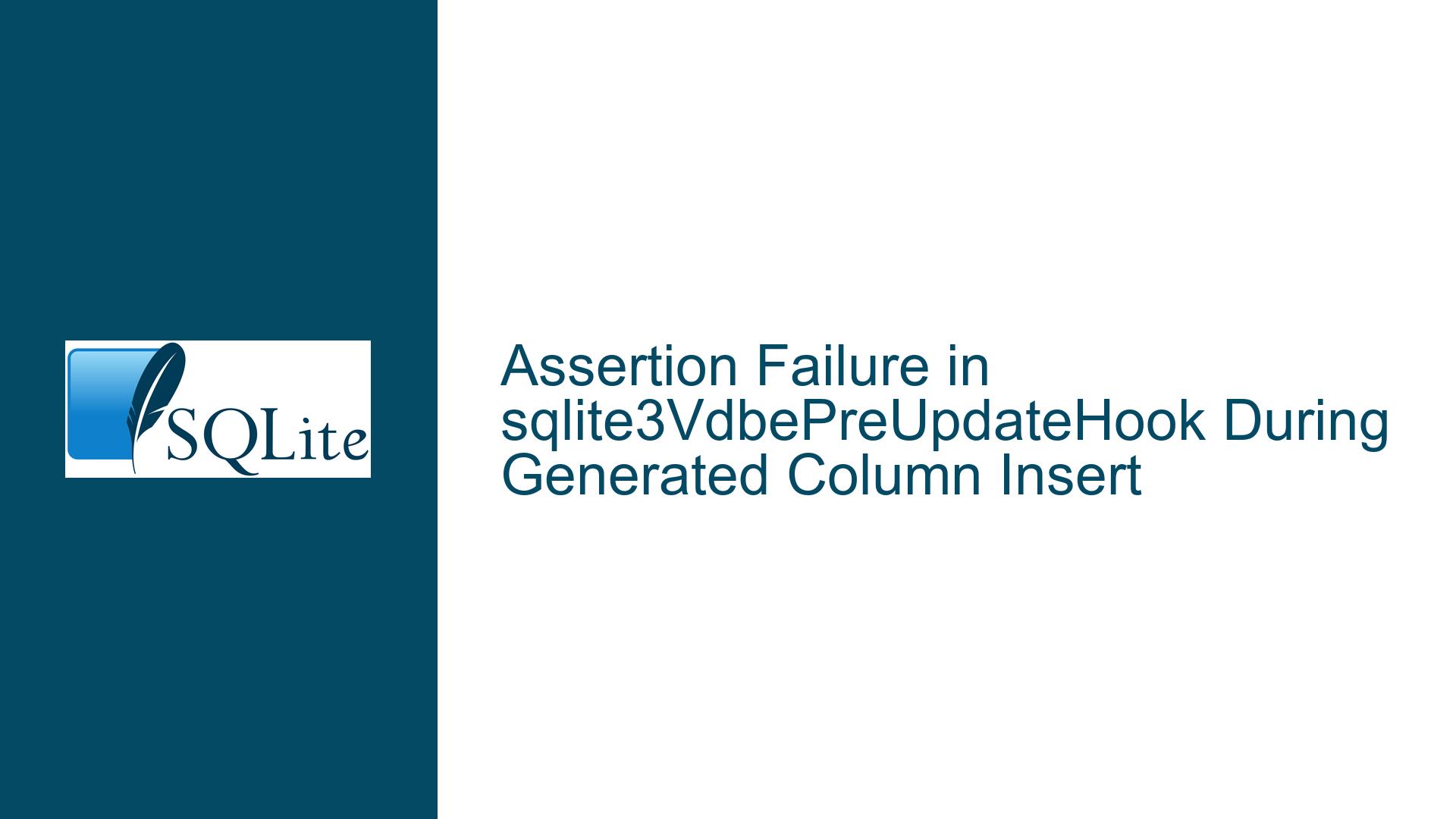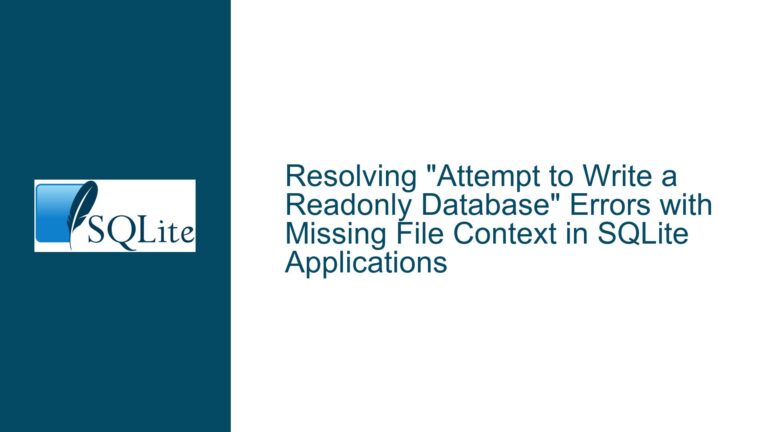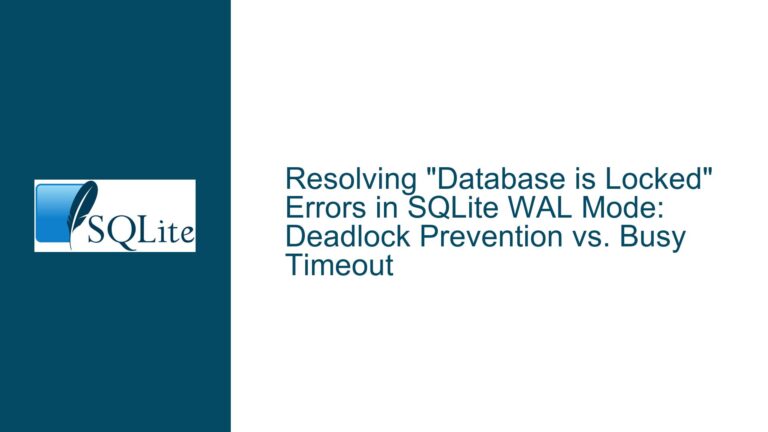Assertion Failure in sqlite3VdbePreUpdateHook During Generated Column Insert
Understanding the Assertion Failure in PreUpdateHook During Schema Modification
The assertion failure in sqlite3VdbePreUpdateHook occurs during the execution of a schema modification operation involving a temporary table with a generated column and a primary key. This error is triggered when SQLite’s virtual database engine (VDBE) detects an inconsistency between the number of fields managed by a cursor (pCsr->nField) and the number of columns in the underlying table (pTab->nCol). The assertion enforces one of two conditions: either the cursor’s field count matches the table’s column count exactly, or (in the case of SQLITE_DELETE operations) the cursor may have one additional field when the iReg parameter is -1. The failure indicates that these conditions were violated during the execution of an INSERT statement into a table with computed columns and constraints.
The temporary table t0 in the example has two columns: a generated column c defined as NULL with a UNIQUE constraint and a primary key column c0. The generated column’s value is computed dynamically, but its UNIQUE constraint implies that SQLite must create an implicit index to enforce uniqueness. The primary key c0 is explicitly defined, which creates another internal index. When the INSERT INTO t0 (c0) VALUES (0) statement is executed, SQLite processes both the base table write and the associated index updates. The sqlite3VdbePreUpdateHook function is part of the mechanism that tracks changes to rows and indexes during write operations. The assertion failure arises because the cursor responsible for managing the write operation does not align with the expected schema configuration, particularly in how fields are counted for generated columns and their associated constraints.
The crux of the issue lies in the interaction between generated columns, unique constraints, and the internal bookkeeping of cursors during write operations. Generated columns that are not stored persistently (i.e., virtual generated columns) require recomputation during writes, which can lead to discrepancies in how cursors are initialized. The UNIQUE constraint on the generated column forces SQLite to validate uniqueness by interacting with the associated index, adding complexity to the write path. Temporary tables exacerbate this because they use separate storage structures (in-memory or temp databases) that may have different optimization paths compared to persistent tables.
Root Causes: Generated Column Constraints and Cursor Field Mismatches
The assertion failure is rooted in three interrelated factors: the handling of generated columns with constraints, the initialization of cursors during write operations, and the interaction with temporary tables.
Generated Columns with Unique Constraints: When a generated column has a
UNIQUEconstraint, SQLite creates an implicit index to enforce uniqueness. However, generated columns can be virtual (computed on-the-fly) or stored (physically saved). In this case, the columncis virtual since it is defined asc AS (NULL)without theSTOREDkeyword. Virtual generated columns are not part of the physical row data, but their constraints still require index maintenance. During anINSERToperation, SQLite must validate the uniqueness ofcby querying this implicit index. The cursor used for this index lookup may not account for the distinction between physical and virtual columns, leading to a mismatch in field counts.Cursor Initialization Logic: Cursors (
VdbeCursorobjects) in SQLite are abstractions for iterating over tables or indexes. When writing to a table, the cursor’snFieldproperty should match the table’snCol(number of columns). However, operations involving indexes (e.g., uniqueness checks) require cursors to access additional fields. The assertionpCsr->nField==pTab->nCol || (pCsr->nField==pTab->nCol+1 && op==SQLITE_DELETE && iReg==-1)expects cursors to either match the table’s column count or have one extra field forDELETEoperations under specific conditions. In this case, theINSERToperation triggers an index update that initializes a cursor with an unexpected number of fields, violating the assertion.Temporary Table Behavior: Temporary tables in SQLite use different storage engines (e.g., in-memory B-trees or temporary database files). These storage engines may have subtle differences in how cursors are managed. For instance, temporary tables bypass certain persistence-related checks, which can lead to optimizations that inadvertently skip cursor initialization steps. The combination of a temporary table, a virtual generated column, and a unique constraint creates a code path where the cursor’s
nFieldis not properly synchronized with the table’s schema.Debug Builds and Assertions: The error manifests in a debug build of SQLite with assertions enabled (
-DSQLITE_DEBUG). Assertions act as runtime sanity checks, and this particular assertion is designed to catch cursor initialization errors that might otherwise go unnoticed in release builds. The presence of other debug flags (ENABLE_TREETRACE,ENABLE_WHERETRACE, etc.) may alter code generation or enable additional logging, but they are not directly responsible for the failure. The core issue is a logical error in cursor field counting, which the assertion exposes.
Resolving the PreUpdateHook Assertion via Schema Adjustments and Pragma Settings
To resolve the assertion failure, address the schema design, cursor initialization assumptions, and SQLite configuration parameters. Below are actionable steps:
Step 1: Modify the Table Schema to Avoid Ambiguous Generated Columns
Generated columns with constraints in temporary tables can create ambiguities in cursor initialization. Redesign the schema to either:
Make the generated column
STORED:CREATE TEMP TABLE t0 (c AS (NULL) STORED UNIQUE, c0 PRIMARY KEY);Stored generated columns persist their values, making them part of the physical row data. This ensures the cursor’s
nFieldaligns withpTab->nColduring writes.Remove the
UNIQUEconstraint from the generated column:CREATE TEMP TABLE t0 (c AS (NULL), c0 PRIMARY KEY);Without the uniqueness check, SQLite avoids creating an implicit index, eliminating the cursor operations that trigger the assertion.
Step 2: Reorder Column Definitions to Simplify Cursor Logic
SQLite initializes cursors based on the order of columns in the schema. Defining the primary key column first may resolve field-counting issues:
CREATE TEMP TABLE t0 (c0 PRIMARY KEY, c AS (NULL) UNIQUE);
This ensures the primary key is processed as the first column, potentially altering how cursors are initialized for index updates.
Step 3: Disable Debug-Specific Assertions for Production Builds
While not a fix for the root cause, disabling assertions in production builds avoids the error:
export CFLAGS="-O2" # Remove -DSQLITE_DEBUG and other debug flags
./configure --disable-debug && make
Note: This masks the symptom but does not address the underlying issue. Use only if the schema cannot be modified.
Step 4: Use PRAGMA Settings to Bypass Constraint Checks
Temporarily defer constraint checks during the transaction:
PRAGMA defer_foreign_keys = ON; -- Affects uniqueness checks in some configurations
BEGIN;
CREATE TEMP TABLE t0 (c AS (NULL) UNIQUE, c0 PRIMARY KEY);
INSERT INTO t0 (c0) VALUES (0);
COMMIT;
This may reduce the number of cursor operations during the INSERT, preventing the assertion failure.
Step 5: Update SQLite to a Version with Patched Cursor Logic
The error may stem from version-specific behavior. Check if the issue persists in newer SQLite versions or official releases (e.g., 3.42.0+). If the problem is resolved in a later version, upgrade using:
git clone https://github.com/sqlite/sqlite.git
cd sqlite
./configure && make
Step 6: Custom Build with Cursor Field Counting Adjustments
For advanced users, modify the SQLite source code to relax the assertion or adjust cursor initialization. Locate the assertion in sqlite3.c:88090 and revise the condition:
// Original assertion
assert(pCsr->nField==pTab->nCol || (pCsr->nField==pTab->nCol+1 && op==SQLITE_DELETE && iReg==-1));
// Revised to allow INSERT operations with nField == nCol + 1
assert(pCsr->nField==pTab->nCol || (pCsr->nField==pTab->nCol+1 && (op==SQLITE_DELETE || op==SQLITE_INSERT) && iReg==-1));
Recompile SQLite after making this change. Warning: This may introduce undefined behavior if cursor field counts are mismatched elsewhere.
Step 7: Monitor VDBE Operations with EXPLAIN
Use EXPLAIN to analyze the VDBE bytecode and identify which cursor operations trigger the assertion:
EXPLAIN INSERT INTO t0 (c0) VALUES (0);
Look for opcodes related to cursor initialization (OpenWrite, OpenRead) and index updates (IdxInsert, IdxDelete). Ensure that the number of fields accessed by these opcodes matches the table’s schema.
Step 8: Avoid Temporary Tables for Schema Prototyping
Test the schema in a persistent database to isolate temporary table-related issues:
CREATE TABLE t0 (c AS (NULL) UNIQUE, c0 PRIMARY KEY);
INSERT INTO t0 (c0) VALUES (0);
If the assertion does not occur, the problem is specific to temporary table handling. Consider using persistent tables with DELETE ON COMMIT clauses as an alternative.
Step 9: Utilize SQLITE_ENABLE_COLUMN_METADATA for Debugging
Compile SQLite with -DSQLITE_ENABLE_COLUMN_METADATA to gain visibility into column attributes during debugging:
export CFLAGS="-DSQLITE_DEBUG -DSQLITE_ENABLE_COLUMN_METADATA"
./configure --enable-debug && make
This allows introspection of column names and types at runtime, aiding in identifying mismatches between cursor fields and table columns.
Step 10: Report the Issue to SQLite’s Maintainers
If the error persists across versions and configurations, file a bug report with the SQLite team. Include:
- A minimal reproducible example
- The assertion failure message
- Compilation flags and platform details
- Observations from
EXPLAINoutput
This contributes to official fixes and improves future releases.






